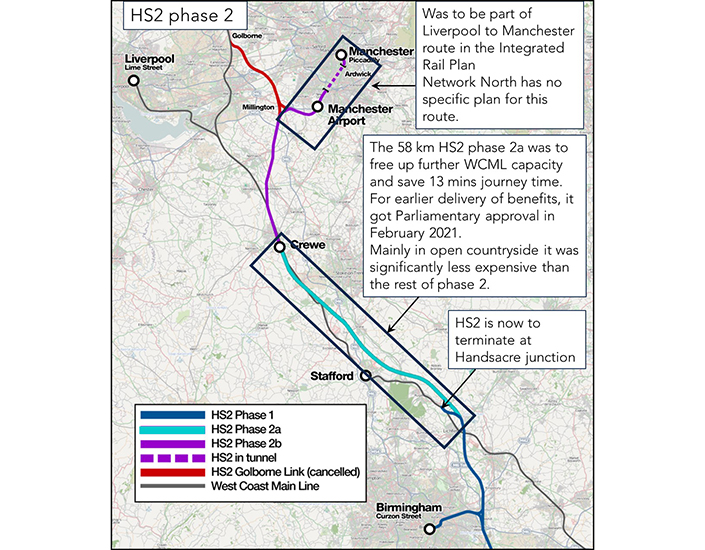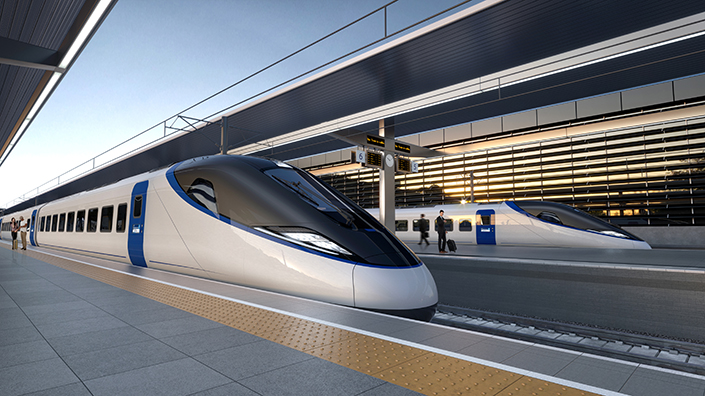Since the announcement, various sources have reported that neither Network Rail nor HS2 Ltd were consulted. Indeed, it is reported that a £300m contract for HS2 Phase 2 work was signed just days before it was announced that Phase 2 was scrapped.
The money saved by cancelling HS2 Phase 2 is now to be spent on a diverse collection of schemes titled Network North, yet most of the spend on Phase 2 was due to take place in the 2030s. These schemes include some that have already been promised, such as the West Yorkshire Metro, and tram lines in Manchester and Nottingham that have already been built.
Network North promises a new station for Bradford, with a new line to Huddersfield that had not been previously mentioned. Without any development, this proposal is a line on a map and a £2bn guessed estimate. It is clear that, in contrast to HS2, which has been the subject of years of development with expert input, the Network North document has been hastily produced with, to quote one report, “the whiff of the hotel photocopier about it”.
It is true that HS2 is a costly project. As described in the Rail Engineer feature “HS2 offered so much”, its initial estimates were overly optimistic and significant costs were added to satisfy objectors.
Since then, HS2 Phase 1’s funding envelope was set at £44.6bn, including £4.3bn contingency (2019 prices).
The HS2 six-monthly report to parliament in June 2023 reported that the total estimated costs for Phase 1 were between £35bn and £45bn, which is around its budgeted price despite construction inflation of 24% since 2019.
The Network North document states that PwC’s High Speed Rail International Benchmarking Study of November 2016 found that the cost per mile of HS2 Phase 1 is five-times that of equivalent schemes in Europe. Yet this study relates to HS2 Phase 2. On page 22 it shows Phase 2 to be 49% more expensive than a comparable high-speed project. Hence, while HS2 is an expensive project, it is not true that its costs were ‘spiralling out of control’.
Getting best value
In the statement cancelling HS2, there was no mention of its benefits or how to maximise the benefits from what remains of the project.
HS2 was intended to provide a step change in capacity, to reduce the productivity gap between London and northern cities. This would also have enabled the rail network to accommodate extra traffic, in particular freight, needed to reduce the nation’s transport carbon emissions.
Yet even with both its Leeds and Manchester legs cancelled, HS2 can deliver significant benefits. It can do so by taking at least 12 trains per hour off the West Coast Main Line (WCML) south of Lichfield, and offering Birmingham, Manchester, Liverpool, Glasgow, and Edinburgh a frequent inter-city service that’s up to 15-minutes faster.

The Network North statement states that: “Phase 1 will now need to be reviewed to make sure only what is required for the reduced HS2 scheme is being delivered.” This statement wrongly implies that a reduced HS2 scheme means a reduced HS2 Phase 1 train service. Instead, the emphasis should be how best to maximise the use of the expensive HS2 Phase 1 line. If its benefits are assumed to be at least equivalent to its cost, the value of an individual train path is in the order of £2bn.
However, no train service has been specified and, instead of maximising Phase 1’s capacity, HS2 is being instructed to review designs to reduce scope while the project is under construction. As anyone involved in project management knows, redesigning a project as it is built is most likely to add costs.
The capacity of the HS2 Phase 1 line is determined by its terminus. Originally it was thought that HS2’s Euston station needed 11 platforms for the full HS2 Y network timetable of 18 trains per hour. The Network North document considered this to be an over-specified gold-plated design, and says that the rescoped station will have six platforms.
This decision to minimise construction costs fails to take account of the required train service. As a result, it is likely that the highly expensive HS2 Phase 1 line will have to run well below capacity, with billions of pounds of benefit wasted.
While the prime minister’s announcement committed to terminating HS2 at Euston, reports since then have indicated that this will not happen unless £6.5bn of private finance can be raised. If the line were to terminate at Old Oak Common, its capacity would be constrained, and half of its potential passengers would find that its 15-minute journey time saving was less than the extra time it took them to get to their destination. Without a central London terminus, it is doubtful whether HS2 would cover its costs.
Train design review needed
In December 2021, a Hitachi-Alstom joint venture signed a £1.97bn contract for the construction of 54 high-speed trains to run on HS2 and conventional lines. These trains will have a top speed of 360km/h on the high-speed line and are 200m long. Two of these trains are to be coupled together for operation to HS2 stations, which are built to accommodate these 400m trains.
Vehicle bodies are to be assembled at Hitachi’s Newton Aycliffe plant, bogies manufactured at Alstom’s Crewe plant, and final assembly to take place at Alstom’s factory in Derby. The first train is expected to be completed in 2027.

An artist's impression of HS2 trains at a platform (Credit: HS2)
A month before the Hitachi-Alstom contract, the government published its Integrated Rail Plan, which cut back the eastern leg of HS2 from Leeds to East Midlands Parkway. At the time, a study of route options to take HS2 trains to Leeds was promised. However, immediately after the HS2 line to East Midlands Parkway was cancelled at the same time as HS2 Phase 2, it was announced that this study is no longer relevant.
With the cancellation of the HS2 lines to both Leeds and Manchester, it is clear that not all the contract’s 54 high-speed trains will be required for likely services. It is understood that this contract is now to be reviewed. This may result in a reduction in the number of trains to be produced, with Alstom/Hitachi paid a cancellation penalty, or the use of surplus trains on conventional routes only.
The design of these trains to run on both the high-speed and conventional lines involves some compromises, which have now become less than ideal with the cancellation of large parts of the planned HS2 network. For example:
- 200m trains are too short on their own. The only dedicated HS2 stations will now be in London and Birmingham. Nowhere else can accommodate two 200m trains together, and the 200m trains are shorter than the 260m Pendolino trains that operate on the WCML.
- European gauge trains will now not run on HS2. It was originally envisaged that half the trains operating on the full Y network would be dedicated HS2 trains built to European loading gauge. As this will not now happen, platform heights and offsets need to be reconsidered. The trains have a high floor and offered level boarding at HS2’s 1,150mm platform height. With only four HS2 stations, this becomes more problematic.
- Trains do not tilt. They will be slower than the current Pendolino trains. This was not considered to be an issue when HS2 trains would have eventually saved 50 minutes on the journey between London and Preston.
In view of the above, a design review of the existing train design is needed to ensure that it is appropriate.
The best hope
Cancelling HS2 was a huge decision. While there was certainly a need to review its cost against its benefits, it is clear that the announcement of the cancellation of Phase 2 at the Conservative Party conference was a rushed decision. It involved no expert input taking account of the project’s benefits, and will incur significant abortive costs. It is astounding that a major project, developed with expert advice over many years, can be cancelled in this way.
With the decision to sell land reserved for Phase 2, it has also been done in a way that will ensure the UK can never have a high-speed rail network, and thus denies the railway its full potential to support economic growth and decarbonise transport through modal shift.
The best that can be hoped for is that the UK’s only remaining domestic high-speed line is able to carry as much traffic as it can. This requires government to deliver on its commitment at Euston, not to otherwise unduly constrain HS2 Phase 1, and for a six-platform Euston station to be designed and operated to maximise train throughput.
This article was originally written for Rail Engineer.
Want the best engineering stories delivered straight to your inbox? The Professional Engineering newsletter gives you vital updates on the most cutting-edge engineering and exciting new job opportunities. To sign up, click here.
Content published by Professional Engineering does not necessarily represent the views of the Institution of Mechanical Engineers.